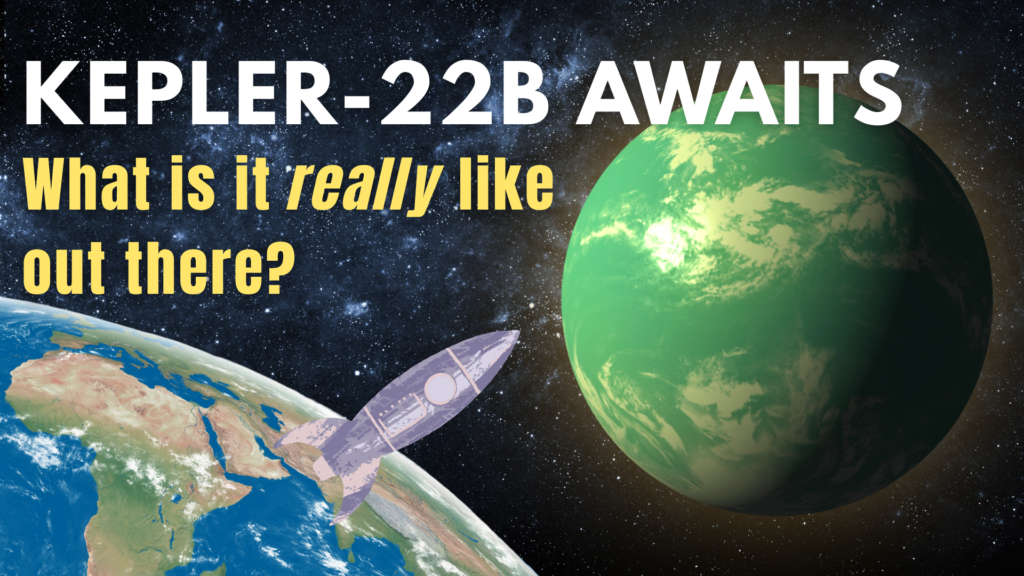Here we have an intriguing article, “Exploring Kepler-22b and Its Alien World.”

A Hypothetical Visit to Kepler-22b — What Awaits Us 600 Light-Years Away?
Picture this: you step out of your spacecraft after a staggering 22-million-year voyage through the cosmic void. Your boots sink into alien soil that no human foot has ever touched. Overhead, a pale, dim sun bathes the land in an eerie teal glow. Is the air breathable? Probably not. Is the ground stable? Every step would be a mystery.
Welcome to Kepler-22b — the first exoplanet humanity discovered in a star’s habitable zone. But what would truly await you if you ever set foot on this distant, alien world?
The Journey: Getting There Is the Biggest Challenge
Let’s face it — we’re nowhere near reaching Kepler-22b. Even aboard our fastest spacecraft, the journey would take millions of years. Hypothetically, if we could someday travel at 10% the speed of light (an astonishing feat we haven’t even begun to approach), it would still take roughly 6,000 years to reach this distant world.
Unless we invent warp drives or master suspended animation, this voyage belongs to the dreams of far-future explorers — or perhaps the ambitious missions of AI probes.
I hope you find this article, “Exploring Kepler-22b and Its Alien World,” useful.
First Steps: What Would the Landscape Look Like?
Imagine you somehow arrive. The first challenge? Gravity. Kepler-22b is more than twice Earth’s diameter, which means its gravity could crush you under almost double your body weight. Walking unaided would be impossible without a high-tech exosuit.
As you glance around, the landscape could vary dramatically. Some scientists speculate it might be a water world — vast, endless oceans with no mountains or dry land, just waves endlessly rolling under a forever-cloudy sky. Or perhaps distant islands break through the mist, their shores lined with alien plants: dark green fronds, bioluminescent fungi, or maybe barren rock and ice.
The truth is, we can only imagine.
The Weather: Expect the Unexpected
If you thought storms on Earth were fierce, Kepler-22b could make our hurricanes look tame. A thick, dense atmosphere might produce titanic storms, with winds strong enough to level anything in their path.
Temperatures could hover around a mild 22°C (71°F) if it mirrors Earth-like conditions. However, without an atmosphere to regulate heat properly, it might swing from boiling during the day to freezing at night in an instant.
In short, pack a reinforced spacesuit, and forget about sunbathing.
Life on Kepler-22b: Is Anything Out There?
Will anything greet you?
The sobering answer is: no one knows. If life exists, it’s most likely microscopic, hidden in the deep oceans or under thick layers of ice. Perhaps you’d find strange alien algae drifting through the water, softly glowing under the muted light of its sun.
No forests. No friendly creatures. Just the silent, unsettling possibility of life, watching from the shadows.
Survival Tips for Future Space Tourists
If you’re dreaming of booking a hypothetical trip to Kepler-22b, here’s your survival checklist:
- Forget the local cuisine. No alien seafood platters — pack your own supplies.
- Bring your own air. Don’t even think about removing your helmet for a dramatic first breath. The atmosphere could be loaded with toxic gases that your lungs would despise.
- Say goodbye to instant messages. A simple “hello” would take 600 years to reach Earth. By the time anyone answers, your great-great-great-grandchildren would be the ones receiving it.
- Tread carefully. This planet might be untouched by life as we know it. Leave no litter, avoid contamination, and bring back everything you take — including that candy wrapper.
- Stay curious, stay alive. Every rock, every drop of water might hold clues to the planet’s history — but one careless step could be your last.
Final Thoughts: A Distant, Haunting Invitation
Today, Kepler-22b remains just a blue speck in a telescope’s viewfinder — a fascinating mystery waiting in the endless dark. Maybe one day, revolutionary engines, brave explorers, or autonomous spacecraft will bridge the cosmic gap between us and this enigmatic world.
Until then, Kepler-22b remains a haunting invitation, a silent world adrift 600 light-years from home, calling to the dreamers, the stargazers, and the restless spirits who dare to ask, “What’s out there?”
So, here’s the question — would you buy a ticket?
If this glimpse into Kepler-22b stirred your imagination, stay tuned for more cosmic adventures, hypothetical missions, and space science discoveries. Subscribe to our blog for the latest updates on exoplanets, astronomy breakthroughs, and the future of space exploration. The universe is vast, and we’ve only just begun to explore it.